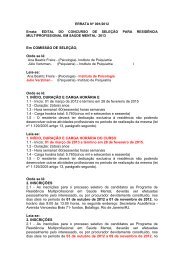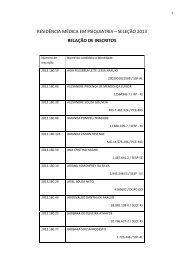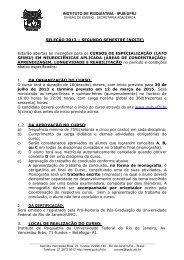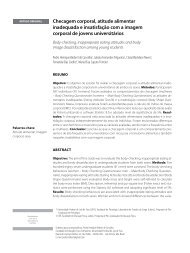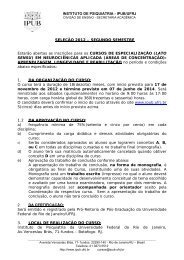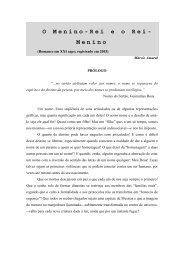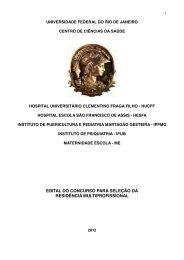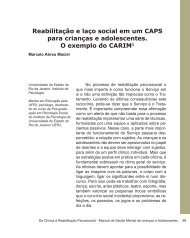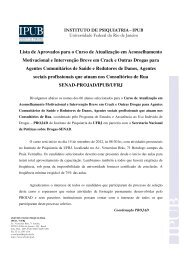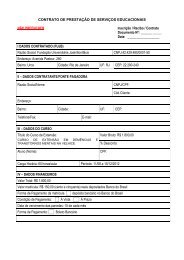Originais â Originals outubro | dezembro ⢠2011 - IPUB - UFRJ
Originais â Originals outubro | dezembro ⢠2011 - IPUB - UFRJ
Originais â Originals outubro | dezembro ⢠2011 - IPUB - UFRJ
Create successful ePaper yourself
Turn your PDF publications into a flip-book with our unique Google optimized e-Paper software.
ORIGINAL ARTICLE<br />
Eating habits and psychopathology in children and adolescents<br />
245<br />
to compare our results with those of other translations and<br />
cultures. Nonetheless, our work may open new avenues of<br />
research in the area of eating habits and psychopathology<br />
in other countries. Third, we only analyzed the results of<br />
the NBI with respect to CBCL indicators, and not with the<br />
respective conclusive diagnoses of the disorders in the<br />
children. However, several studies have well documented<br />
that the CBCL has good convergence with structured<br />
psychiatric interview 16,31-35 . Fourth, because of the research<br />
characteristics of our center, we could only include children<br />
and adolescents in the sample. Thus, we do not know<br />
whether the NBI as translated would be useful for the adult<br />
population in Brazil. This indicates that further research<br />
validating our already translated NBI may be tested in an<br />
adult Brazilian population.<br />
In spite of the limitations mentioned above, the results<br />
presented indicate that the NBI has sensitivity for identifying<br />
psychopathological symptoms related to the dietary habits of<br />
children and adolescents (Figure 1). It supports current data<br />
in the literature that suggests that emotional difficulties and<br />
problems are correlated with eating habits and consumption<br />
of so-called junk-food 36,37 . Furthermore, early studies showed<br />
that adolescents who together with their parents exhibited<br />
aggressive behavior had very high NBI scores 10 . The present<br />
study showed that pre-adolescents with social problems,<br />
aggressive behavior issues, and conduct problems also had<br />
NBI scores above the cut-off point of 30 (Figure 1). Certainly,<br />
additional studies are needed to extend our seminal findings.<br />
In addition, studies suggest that children who eat more<br />
junk-food may have nutritional imbalances over the longterm,<br />
since these foods are normally rich in sugar and fat,<br />
and in many instances, contain additives, food coloring,<br />
and preservatives, and provide poor quality nutrition 36 .<br />
Consumption of junk-food has been shown to make<br />
adolescents more prone to hyperactivity and attention<br />
problems, as well as other emotional problems that are<br />
often comorbid with these conditions, such as behavioral<br />
disorders and social problems 37 . High consumption of<br />
caffeine and sugar, mainly in the form of soft drinks, has been<br />
associated with aggressive behavior, ADHD, social problems<br />
and somatic complaints 38 .<br />
An unhealthy dietary regimen can also be considered<br />
a subjacent symptom of mental disorders 39 . In addition,<br />
changes in the reward circuit of the brain during puberty<br />
can also be related to depressive symptoms in adolescents.<br />
It is possible; however, that an increase in reward seeking<br />
behavior, at this point in development, may compensate for<br />
changes in affect 40 .<br />
The continual search for foods that are very tasty,<br />
though being poor in nutritional value, uses neutral paths<br />
of behavioral reinforcement, including the dopaminergic<br />
system, progressively degrading the equilibrium of the brain’s<br />
reward circuit and thereby generating more consumption<br />
and a compulsion for this type of food. This circumstance,<br />
termed “dietary dependence”, is considered a mental health<br />
risk factor, especially during childhood and adolescence 40 .<br />
Mood, anxiety disorders and substance abuse disorders<br />
are among the most studied, common, serious, and<br />
incapacitating disorders that arise during adolescence 41 .<br />
Moreover, the manifestation of these disorders during early<br />
adolescence is associated with subsequent development<br />
of serious forms of these diseases, and anxiety symptoms<br />
often precede mood disorders during childhood and<br />
adolescence 40 . Therefore, this issue in and of itself underscores<br />
why early diagnosis and detection of risk factors for mental<br />
health problems during these phases is crucial.<br />
Conclusion<br />
The presently developed Portuguese-language NBI is the first<br />
instrument that allows for triage to evaluate emotional and<br />
behavioral problems and dietary habits related to behavioral<br />
and mood disorders in Portuguese speaking people. The presently<br />
reported analyses of its internal consistency after translation<br />
and adaptation when administered to Brazilian children<br />
and adolescents offer sufficient proof of its validation. Furthermore,<br />
our results suggest that there is a strong association<br />
between NBI findings and CBCL psychopathological indicators<br />
for several mental health problems, such as depression,<br />
anxiety, attention problems, aggressiveness, and conduct<br />
and social problems. The indicators for externalizing and total<br />
problems were also significant.<br />
The results presented in this study suggest that poor diet<br />
may be associated with mental disorders and demonstrate<br />
that the NBI can be used for early identification of symptoms<br />
of emotional problems and behaviors and related dietary<br />
habits in an inexpensive, easy, and rapid manner. The<br />
NBI is easy to administer in walk-in clinics or by teachers<br />
in schools, thus facilitating the early identification of risk<br />
factors that contribute to mood or behavioral disorders.<br />
NBI findings can also serve as a basis for planning possible<br />
complementary actions and therapeutic interventions, such<br />
as modifying dietary habits or secondary prevention tactics.<br />
Such interventions can prevent problems from progressing<br />
or becoming chronic, which is important considering<br />
adolescents’ vulnerability to mental illness.<br />
ACKNOWLEGMENTS<br />
This study was supported by the State of Paraná Department<br />
of Science and Technology (SETI nº 003/07) and the State<br />
Health Department (SESA nº 009/07), Mr. Norbert Gehr and<br />
the UCLA Foundation. We thank social worker Ms. Rosilda<br />
Ferreira for her assistance, the public school teachers, the<br />
J Bras Psiquiatr. <strong>2011</strong>;60(4):240-6.




